Planning and checking
![Hochwannig]() Hochwannig and Bergtal, situation in the morning
Hochwannig and Bergtal, situation in the morning
Some adventures are kept in mind forever. For me this happened on April, 21th, 2012.
That April weather was instable and cold, ways too cold compared to normal. Our Bavarian and Tirol summits still were snow and rime packed.
Nevertheless my friend R. and I planned a ski tour on that Saturday as the weather forecast promised a nice day before another frontal trough would hit the northern Alps.
As usual we checked the Tirol avalanche bulletin. It promised moderate avalanche danger (grade 2) with a vague threat from wind slab avalanches on northern and northeastern high slopes and no dangerous stratification in the deeper parts of the snow cover.
We decided to summit
Hochwannig, a nice ski tour in the
Mieming range. The route starts on the local ski runs, in April already abandoned, and uses the Hochwannig northeastern cirque, called
Bergltal, up to a northern chute, which leads steeply to the summit plateau.
The route is well-known and is done frequently. Despite of the slight avalanche threat on northern slopes we decided that the snow already should be worked over by skiers of the previous days and weeks and thus the slopes would have lost their normal, natural snow stratification which might cause trouble.
Approach
![Hochwannig]() Ascending Bergltal - old avalanche conus
Ascending Bergltal - old avalanche conus
We started early in Munich and rushed towards Garmisch-Partenkirchen. There were low clouds keeping the mountains out of view. On our way to Ehrwald the clouds suddenly disappeared and we caught the first glimpse of Hochwannig. The mountain was completely snow wrapped, rime packed and looked more like a Patagonian summit than an Austrian mountain.
“I don´t like that” I said slightly surprised. “There seems to be ways more fresh snow than I expected from the weather forecast and the avalanche bulletin.”
R agreed and we worked out an avalanche check strategy for the day.
The ski runs would be no problem. We would check the snow when traversing from the ski runs into Bergltal first.
Arriving at Bergltal we would check the situation a second time because of the steep northern slopes of Handschuhspitze, a secondary summit and the culmination point of the Hochwannig east ridge.
The third and last check was intended in the upper part of Bergltal slope, near the summit chute.
The day started quite normal and as expected. There were already many cars parking at the trailhead what means: a couple of ski tourists ahead preparing the ski track for us. There were still high clouds around but blue sky could be seen in the far west.
![Hochwannig]() Snow drift signs
Snow drift signs | ![Hochwannig]() Bergltal, north faces
Bergltal, north faces | ![Hochwannig]() Bergltal slope
Bergltal slope |
Working up the ski run was rather dull but at least a good warming up for what would follow. After a bit more than an hour we reached the mountain inn near
Marienbergjoch. We started the long and nearly level traverse into Bergltal.
Strong gusts of wind caused some snow drift and we recognised the first wind – caused snow accumulations at the first appointed avalanche checkpoint. In front of us stood out Hochwannig snow-white against the blue skies. Some old avalanche cones could be seen, the already visible ascent track crossed them several times. I cannot deny that I was a bit nervous about the snow drift but we had another two avalanche checkpoints ahead.
![Hochwannig]() Bergltal slope and Hochwannig
Bergltal slope and Hochwannig
We reached the lower parts of Bergltal and the long traverse below the steep north faces of Handschuhspitze. There we had to cross several old avalanche cones. Obviously these avalanches had fallen the previous days due to recent snow drift accumulation. The good news for us: no more avalanche danger in this area; most of the accumulated snow had already swept down the north faces. So we decided to continue ascending to the third and last avalanche checkpoint.
This checkpoint was high up Bergltal slope near the beginning of the summit chute. Working up Bergltal we saw about 20 people in front of us, zigzagging up the mountain. There was a good ascent ski track and already several fresh downhill ski tracks of some early birds. There was also a broad old avalanche cone we had seen already from Marienbergjoch inn, ranging from top of the slope midway down. Some side chutes had already unloaded their snow burden so the situation seemed to be a bit less threatening. Deeper and hidden weak snow layers were no subject of the actual avalanche bulletin. This meant to us: snow worked over, less danger!
My caution diminished slowly. There was sun, fresh snow, blue skies, a good and not too steep ski track and the prospect of a good downhill fun. We had about 2/3 of the slope behind us.
Avalanche
Then, all of a sudden, there was a cry from above.
“
Avalanche!”
And more cries of shock from the people ahead of us.
![Hochwannig]() after the avalanche hit
after the avalanche hit
“Out of here” I shouted to R. and I spun around to leave the slope to my right were some rocks were limiting the slope and would give a shelter against the avalanche. At the same time I looked up the mountain to check the situation.
There it was. A meter - high white wall of snow came down and out of the summit chute which opens out into the Bergltal slope right-angled. So the avalanche first surged up the counter slope and then fell down the Bergltal slope with an incredible pace.
Watching that, R. and I started to ski down to the rock shelter. R., being closer to them, arrived at the rocks within five seconds despite of the skins on the bottom of the skies and the binding, which naturally was open at the heel for ascending purposes.
I had less luck. Starting the descent to the rocks and watching the avalanche at the same time, panic rose inside me and I stupidly stumbled across some old avalanche debris and fell head first into the snow. Within two seconds I stood up again to continue my escape but it was too late. The avalanche hit me when I restarted my descent and knocked me off my feet.
Again head first a descent of another sort began. I automatically began to “swim”. The avalanche tried to suck me in and I struggled to resist but I had no orientation whether I was up or down, left or right. The force of the avalanche was irresistible and pitiless. Snow was everywhere. The most incredible thing was: it was a nearly silent force. There only was a distant swooshing noise.
![Hochwannig]() Helicopter rescuing an injured person
Helicopter rescuing an injured person
I think the whole journey lasted only seconds. For me it lasted endlessly. Then the speed diminished and the forces let go. I tried to manage to have a hole for breathing for the moment the whole thing would stop. Then there was no more movement.
Immediately I tried to free myself and to regain control. As once I experienced an avalanche incident, where a second avalanche came down after the first one, because the snow in some chutes far above unloaded, I feared the same thing now.
I could hardly believe it myself but I was not buried completely. I could free my head and upper part of my body immediately, only my feet stuck deeply in the snow. I searched R., there he was, about 100 meters of altitude difference above me, outside of the avalanche. I waved in his direction and shouted that everything seemed to be o.k. I looked up the slope and I saw between the tumble of snow people everywhere trying to free themselves out of the avalanche.
I managed to get my feet out of the snow. Then I checked my whole body for damages and injuries. I felt a slight shock spreading and I concentrated hardly to find my skies, my sunglasses, my ski poles. My sunglasses were in front of me. I still had one ski pole in my left hand, the other one was lying only two meters away. One ski was on my left foot, the other one was lost somewhere.
![Hochwannig]() Extend of the new avalanche
Extend of the new avalanche
I was calming down and looked closer up to the people, freeing themselves out of the avalanche. I started to count them and it seemed to me that nobody was buried completely. With only one ski I had no chance to join a search but I automatically put my avalanche transceiver to “search” to check my surroundings. Thank God the thing did not receive a signal.
A man started from far above to zigzag down the whole avalanche cone, obviously doing a first search. When he arrived at me he said that there seemed to be no one buried or missed. What good news.
R. started to ascend to a woman, lying about 150 m above me in the snow and shouting for help. He later told me that her knee was injured, she had a bad shock and he was talking constantly to her to prevent her from fainting. She told him that it was her first ski tour and her company, some six people, told her that Hochwannig is an easy route. Hochwannig is definitively not an easy ski tour.
I saw now that nearly the whole Bergltal slope was flooded by the avalanche cone. As the slope broadens immediately after the summit chute opens into the slope, the avalanche quickly lost depth and gets a broad and flat one. This was the incredible luck for about 20 people. Nobody gets buried, only the unlucky woman had an injuried knee.
Less than 10 minutes after the incident a first helicopter arrived and checked the situation. The pilot headed in my direction first and I made the big N for “No help needed” and pointed up to the injured woman. She then get first aid immediately and could leave the scene five minutes later. A second helicopter, this time with police, arrived to record the incident. A third one brought a search crew with an avalanche search dog. All that happened in less than 15 minutes.
A young couple started to descent the avalanche cone slowly, the woman still looking chalky. She suddenly said “oh look another ski over there”. “Is it a red one?” I shouted. They nodded. “That seems to be mine, please bring it down to me.”
Incredibly enough I also get back my second ski.
Rethinking
![Hochwannig]() Bergltal situation in the afternoon
Bergltal situation in the afternoon
R. and I descended slowly back to the Marienbergjoch mountain inn. There is a mountain hut near the inn and there we took a long break in the sun. We tried to understand why there was such an avalanche possible despite of the snow situation and the positive outcomes at our checkpoints.
As R. had the chance to survey the whole event we found out the following:
At the upper end of the summit chute there is a huge slab which obviously was packed with drift snow.
Immediately after the avalanche fell down, R. observed a group of three skiers coming down a parallel chute. This chute can be reached only by traversing the above mentioned slab. It seems that these mountaineers caused a small slab avalanche which hit the upper summit chute with full force.
The force was strong enough to sweep away the whole soft snow lying in the summit chute and probably to unchain, too, the snow load of several side chutes of the summit block. Thus the avalanche building process was kept going despite of the worked over snow in the chute and across the Bergltal slope.
The incredible thing was: these skiers did not feel obliged neither to look after the people involved in the incident nor to help. As R. told me they just looked at the scene from far for a while and then continued their descent.
Next weekend saw me on Watzmann summit with skies: keep on moving! “Keep on moving” is necessary to not lose the grip after such an incident. But R. and I are discussing even more now the avalanche situation.
Was the incident predictable if you take into account the avalanche bulletin for that day? Did we choose the wrong ski tour? Did we underestimate the avalanche threat?
I think we were right to fix three checkpoints on our Hochwannig day.
![Hochwannig]() Bergltal, Mieming range and Zugspitze
Bergltal, Mieming range and Zugspitze
Did the avalanche bulletin underestimate this threat? Fact was, next day they put in danger grade 3 due to several avalanche incidents the day before.
Would we have tried to summit Hochwannig with danger grade 3?
What I understood was: worked over snow can diminish the avalanche threat of a slope or chute but if a lateral slope, rockface or chute unloads its snow cover, a “worked-over slope” can not unconditionally hold back avalanche building processes. The fault was not to take these facts into account despite of the avalanche bulletin, my bad feelings and our knowledge of the terrain.
I always was alert about avalanches in the past and now I am even more prudent. This ski tour season (2012/2013), we had two or three weekends with a rather murky snow and avalanche situation and danger grade 2 / 3 in the bulletins. I decided to stay at home. If I can help it I don´t want to be in such a situation again.







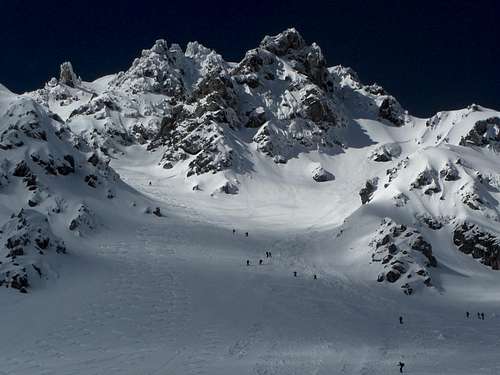
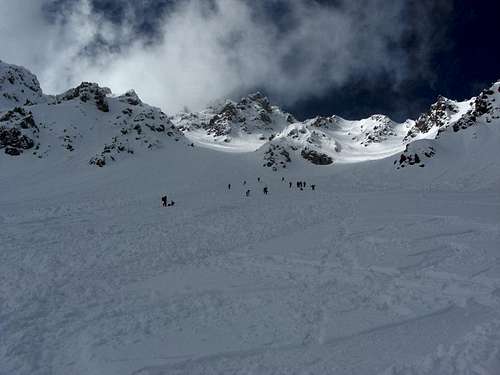
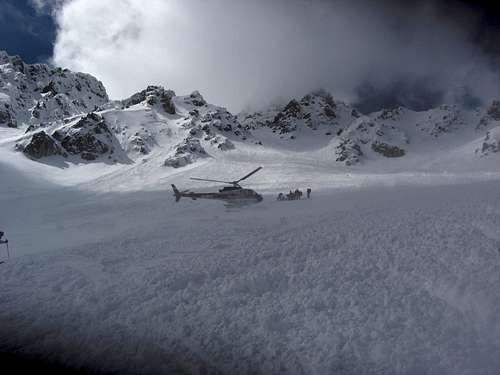
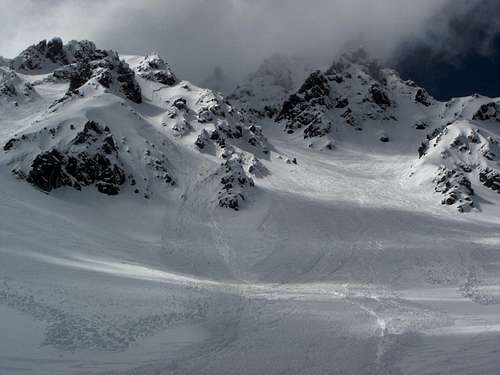
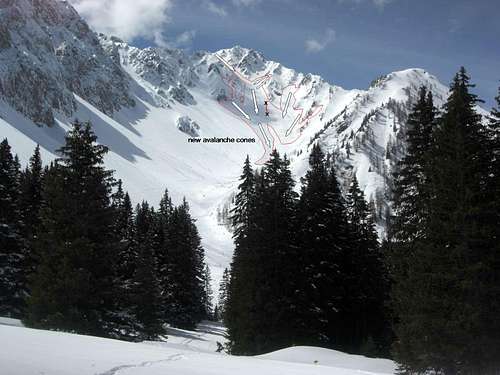
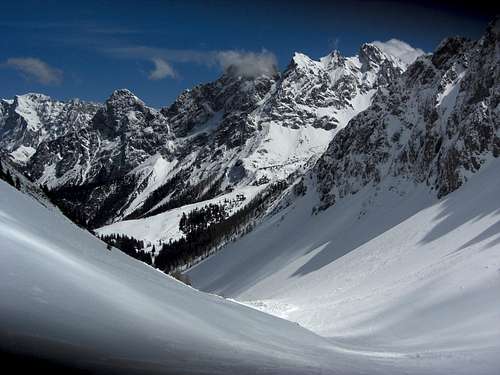


Comments
Post a Comment